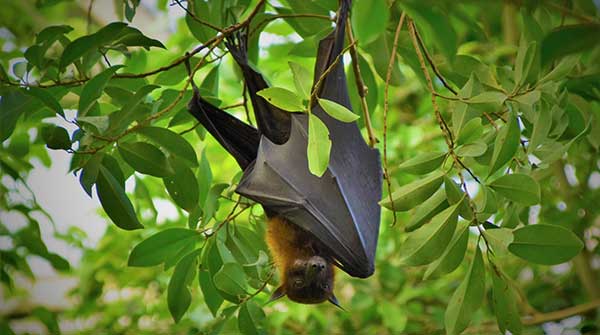Vampire bats and vampire moths are sanguivores. Blood is their primary or exclusive source of food
 Vampire bats are sanguivores. That’s zoology-speak for “they drink blood.” Gross? Absolutely.
Vampire bats are sanguivores. That’s zoology-speak for “they drink blood.” Gross? Absolutely.
But it’s not just a party trick. Once a vampire bat gets old enough to stop drinking its mother’s milk, blood becomes the only food it will ever consume again.
No other mammal does that, so sanguivory has made vampire bats totally different from other mammals, especially from other bats. No other bat can run on the ground, but vampire bats do. No other bat shares food with non-relatives, but vampire bats do. No other bat can slice your skin like a razor blade, but vampire bats do. To me, that distinctiveness has always been the best thing about them.
I’ve been obsessed with bats for decades: I eventually studied them for my master’s and PhD. I first fell in love with bats when I read a book about them in high school. Excited to learn more, I got my bachelor of science degree in zoology at the University of Alberta. And I remember how frustrated I was in my first zoology class because of how little content there was on bats. The professor, Reuben Kaufman, kept going on about his favourite research subjects, ticks, and all I could do was keep imagining how much more I’d get out of the course if only he’d been a bat biologist. I didn’t want a tick talk!
 Photo by Waldemar |
| Related Stories |
| What’s so great about a dead tree?
|
| Do Japanese Beetles taste yucky?
|
| Where do fish go in the winter?
|
But in the past decade or so, I’ve stepped outside academics to work as a science journalist, and that has forced me to cast my gaze more broadly. It has permitted me to learn more about the wider world, and that perspective has given me a new way of seeing bats, especially the vampires.
Vampire bats aren’t the only sanguivores. Plenty of fish, worms, insects, arachnids and even birds also drink blood. I’d always known that, of course, but I’d ignored the science around those other animals because it seemed too tangential to my work. My research was on the biomechanics of vampire bat walking. Why would I learn about leech saliva?
But having given those other animals a closer look in recent years, the vampire bats suddenly don’t seem unique. Instead, I can now see how eerily similar they are to other blood-drinking animals. And if you don’t mind a little gore, I think the diversity of blood-feeding animals is well worth a quick tour.
The vampire moth Calyptra of Southeast Asia has a one- to two-centimetre-long proboscis (feeding tube) like the butterfly in your garden does. But instead of drinking nectar, it stabs the skin of animals – including humans – to drink their blood. Many other moths feed on tears near the eyes of animals as a way of getting salt. A lot of experts think the vampire moth got its start that way but got a little carried away when feeding at the corner of the eyeball and developed a taste for the salty red stuff that came out when it probed a little too hard.
The eye socket is also the target for Colubraria reticulata, the vampire snail – a roughly six-centimetre-long animal you’ll only ever see if you go snorkelling at night in the tropical reefs of Southeast Asia. The snail’s strategy is to extend a very long proboscis (up to three times its body length) into the eye socket of a sleeping fish. Just how that habit evolved is a mystery, but as to whether it’s gross or not, there’s no debate.
Another fascinating blood-feeder is the jumping spider Evarcha. It doesn’t feed on blood directly, though. (No spider does, thank goodness.) But it does need blood to make pheromones to attract a mate. So it gets blood second-hand, taking it from the belly of a parasite. The spider hunts mosquitoes, preferentially focusing its efforts on females that have just had a blood meal.
Blood-feeding is everywhere. It has evolved at least two dozen times among animals. And because the challenges of that diet are basically the same for all sanguivores, there are lots of ways in which they have become quite similar to one another. Vampire bats are a perfect example.
Vampire bats use smell to find their victims, like bed bugs do. They can sense temperature differences on the skin to find blood vessels, like mosquitoes do. They have proteins in their saliva that stop blood from clotting while they feed, like leeches do. And since blood is so watered down, vampire bats drink as much as they can in a single meal, like ticks do. These characteristics differentiate vampire bats from other bats while making them similar to other sanguivores.
I spent decades investigating bats as an academic, but journalism has broadened my perspective and helped me see bats differently. I feel like an astronomer, stepping back from my telescope to look up, awestruck by the expanse of twinkling stars.
I recently submitted a paper about vampire bats to The Canadian Journal of Zoology to show them in this broader light. In the paper, I mention how vampire bats can increase their body weight by 50 per cent in a single meal and that this fits the pattern of other blood-feeders. Looking through the literature, I learned that mosquitoes can drink 180 percent of their body weight in one meal, and that medicinal leeches average an increase of 890 percent in just 29 minutes. But the record-holder? The tick, specifically the mated female of the ixodid family, is capable of increasing its body weight 100-fold when it feeds.
And when I went to cite the tick paper and checked the name of the author, I couldn’t believe it: Reuben Kaufman!
Twenty-nine years later, my professor’s tick talk had finally hit its mark.
Dan Riskin is a bat biologist, science journalist, author and recipient of a 2015 Distinguished Alumni Award. His first picture book for kids, Fiona the Fruit Bat, is out now.
This article was submitted by the University of Alberta’s Folio online magazine, a Troy Media Editorial Content Provider Partner.
The opinions expressed by our columnists and contributors are theirs alone and do not inherently or expressly reflect the views of our publication.
© Troy Media
Troy Media is an editorial content provider to media outlets and its own hosted community news outlets across Canada.

